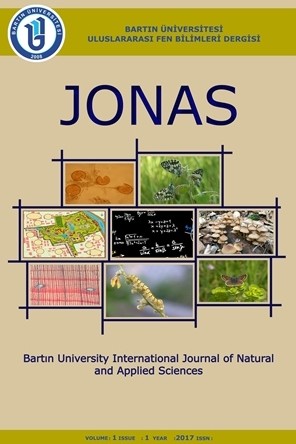EFFECT OF BIOMASS HYDROLYSATE ON SOIL AND PLANT PHENOLIC CONTENTS
EFFECT OF BIOMASS HYDROLYSATE ON SOIL AND PLANT PHENOLIC CONTENTS
In this work, non-edible biomass hydrolysates were used as a kind of fertilizer to investigate their influences on sandy and loamy soils. Biomass hydrolysates were extracted by subcritical water process. Three different concentration of biomass hydrolysates (1000, 2500, 4000 ppm C) were used to investigate their influences on the different soil types. The pH of soil sample was slightly neutral and alkaline for sandy and loamy soils, respectively. There were no significantly a difference on total soil nitrogen. Total carbon content increased with increasing biomass concentrations. Total water soluble phenolic contents, elements (Na, Ca and K) in bean leaves irrigated with biomass hydrolysates were determined. According to results, total water soluble phenolic contents of leaves increased in following order 40P < 25P < 10P. Significant differences were obtained in potassium and calcium contents while no considerable changes were found in sodium contents of bean leaves in different growing media.
Keywords:
Kenaf, green fertilizer, kenaf hydrolysate, phenolic compound sandy soil,
___
- 1. Alistair F. (1979). Pitty Geography and soil properties, Taylor and Francis.
- 2. Aydemir O. (1979). Fertilizers and environment pollution. Ataturk University Journal of Agr. Fac. 10 (3-4): 189-197.
- 3. Barraclough D., Geens E.L. & Maggs J.M. (1984). Fate of fertilizer nitrogen applied to grassland. II. Nitrogen-15 leaching results. 35(2):191–199.
- 4. Bartolomé B., Estrella I. & Hernándes T. (1997). Changes in phenolic compounds inlentils (Lens cullinaris) during germination and fermantation. Z Lebensm Unters Forsch A. 205 290- 294.
- 5. Bauer A. & Black A.L. (1994). Quantification of the effect of soil organic matter content on soil productivity. Soil Sci. Soc. Am. J. 58, 185–193.
- 6. Bayraklı F.(1990). Ammonia volatilization losses from different fertilizers and effect of several urease inhibitors, CaCl2 and phosphogypsum on losses from urea. Fertilizer Research. 23 147-150.
- 7. Bouyoucos G.H. (1951). A Recalibration of the Hydrometer for Making Mechanical Analysis of Soils. Agronomy Journal. 43:434-438.
- 8. Caboni E., Tonelli M.G., Lauri P., Lacovacci P., Kevers C. & Damiano, C. (1997). Biochemical aspects of almond microcuttings related to in vitro rooting ability, Biologia Plantarum. 39:91–97.
- 9. Doran J.W. & Parkin T.B. (1994). Defining and assessing soil quality. Doran, J.W., et al., (Eds.), Defining Soil Quality for a Sustainable Environment. Special Publication No. 35. Soil Science Society of America, Madison, WI, pp. 3–21.
- 10. Dormaar J. F. C., Lindwall W. & Kozub G.C.(1986). Restoring productivity to an artifically eroded Dark Brown Chernozemic soil under dryland conditions. Can. J. Soil Sci. 66, 273-285.
- 11. Duchaufour P. (1970). Precis de Pedologie. Masson et C1e, Editeurs, Paris.
- 12. FAO (2016). FAOSTAT, Food and Agriculture Organization of the United Nations, Rome, Italy.
- 13. Irmak S. & Öztürk I. (2010). Hydrogen rich gas production by thermocatalytic decomposition of kenaf biomass, International Journal of Hydrogen Energy. 35(11), 5312-5317.
- 14. Jackson M.L. (1958). Soil Chemical Analysis. 214-221.
- 15. Kaya B., Irmak S., Hasanoglu A. & Erbatur O. (2014). Evaluation of various carbon materials supported Pt catalyts for aqueous-phase reforming of lignocellulosic biomass hydrolysate, Int. J. Hydrog. Energy, 39: 10135–10140.
- 16. Meryemoglu B., Hesenov A., Irmak S., Atanur O.M. & Erbatur O. (2010). Aqueous phase reforming of biomass using various types of supported precious metal and raney nickel catalysts for hydrogen production. Int Hydrogen Energy. 35, 12580-12587.
- 17. Meryemoglu B., Hasanoglu A., Kaya B., Irmak S. & Erbatur O. (2014). Hydrogen production from aqueous-phase reforming of sorghum biomass: an application of the response surface methodology. Renew Energy. 62, 535-41.
- 18. Ozturk I., Irmak S., Hesenov A. & Erbatur O. (2010). Hydrolysis of kenaf (Hibiscus cannabinus L.) stems by catalytical thermal treatment in subcritical water, Biomass and Bioenergy, 34(11), 1578-1585.
- 19. Tokay F. & Yaşar S.B. (2008). Topraktaki hümik asit miktarina bağlı olarak zeytin toprağı, zeytin yaprağı ve zeytinin meyvesinde çinko miktarinin değişimi. Ulusal Zeytin Öğrenci Kongresi, 17-18 Mayıs 2008 / Edremit-Balıkesir.
- 20. Yano Y., McDowell W.H. & Aber J.D. (2000). Biodegra-dable dissolved organic carbon in forest soil solution and effects of chronic nitrogen deposition. Soil Biology and Biochemistry, 32: 1743-1751.
- 21. Zhang C.H., Wang Z.M., Ju W.M. & Ren C.Y. (2011). Spatial and Temporal Variability of Soil C/N Ratio in Songnen Plain Maize Belt, Environmental Science, 32: 1407-1414.
- 22. URL-1 (2015). https://permaculturenews.org/2015/10/13/how-soil-and-carbon-are-related/
- Yayın Aralığı: Yılda 2 Sayı
- Başlangıç: 2017
- Yayıncı: Bartın Üniversitesi
Sayıdaki Diğer Makaleler
LAVANTA TARIMI VE SÜRDÜRÜLEBİLİR KALKINMA: ISPARTA/KEÇİBORLU-KUYUCAK KÖYÜ ÖRNEĞİ
Yeliz TARHAN, Sebahat AÇIKSÖZ, Deniz ÇELİK
CONTRIBUTIONS TO THE SOLUTION OF PHYLOGENETIC PROBLEM IN FABALES
Deniz AYGÖREN ULUER, Rahma ALSHAMRANI
SERBEST ORMANCILIK BÜROLARININ HUKUKSAL SORUNLARI VE ÇÖZÜM ÖNERİLERİ
SAMSUN-ÇARŞAMBA’DA PLANLAMA SÜRECİNİN KENTSEL PEYZAJ AÇISINDAN İRDELENMESİ
Süheyla ÜNAL, Mustafa KARAKAPLAN, Erdinç ÖZ, İsmet YILMAZ, Serdar ALTIN, Ali BAYRİ
KENTSEL DÖNÜŞÜM PROJELERİNE EKOLOJİK BOYUT KAZANDIRILMASINA İLİŞKİN GÖRÜŞLER
Meltem DEMİRTAŞ, Selma ÇELİKYAY
BAZI ARPA GENOTİPLERİNDE KURŞUN TOLERANSININ KLOROFİL A FLORESANSI İLE DEĞERLENDİRİLMESİ
